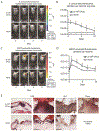Research Techniques Made Simple: Mouse Bacterial Skin Infection Models for Immunity Research
- PMID: 32407714
- PMCID: PMC7387158
- DOI: 10.1016/j.jid.2020.04.012
Research Techniques Made Simple: Mouse Bacterial Skin Infection Models for Immunity Research
Abstract
Bacterial skin infections are a major societal health burden and are increasingly difficult to treat owing to the emergence of antibiotic-resistant strains such as community-acquired methicillin-resistant Staphylococcus aureus. Understanding the immunologic mechanisms that provide durable protection against skin infections has the potential to guide the development of immunotherapies and vaccines to engage the host immune response to combat these antibiotic-resistant strains. To this end, mouse skin infection models allow researchers to examine host immunity by investigating the timing, inoculum, route of infection and the causative bacterial species in different wild-type mouse backgrounds as well as in knockout, transgenic, and other types of genetically engineered mouse strains. To recapitulate the various types of human skin infections, many different mouse models have been developed. For example, four models frequently used in dermatological research are based on the route of infection, including (i) subcutaneous infection models, (ii) intradermal infection models, (iii) wound infection models, and (iv) epicutaneous infection models. In this article, we will describe these skin infection models in detail along with their advantages and limitations. In addition, we will discuss how humanized mouse models such as the human skin xenograft on immunocompromised mice might be used in bacterial skin infection research.
Copyright © 2020 The Authors. Published by Elsevier Inc. All rights reserved.
Conflict of interest statement
CONFLICT OF INTEREST
L.S.M. is a full-time employee at Janssen Research and Development and may own Johnson & Johnson stock and stock options. L.S.M. has received grant support from AstraZeneca, MedImmune (a subsidiary of AstraZeneca), Pfizer, Boerhinger Ingelheim, Regeneron Pharmaceuticals, and Moderna Therapeutics, is a shareholder of Noveome Biotherapeutics, was a paid consultant for Armirall and Janssen Research and Development and was on the scientific advisory board of Integrated Biotherapeutics, which are all developing therapeutics against infections (including
Figures


References
-
- Alexander H, Brown S, Danby S, Flohr C. Research Techniques Made Simple: Transepidermal Water Loss Measurement as a Research Tool. J Invest Dermatol 2018;138(11):2295–300.e1. - PubMed
Publication types
MeSH terms
Grants and funding
LinkOut - more resources
Full Text Sources
Medical

